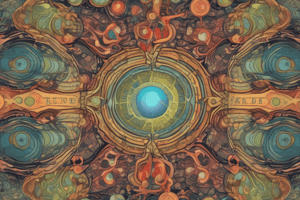Podcast
Questions and Answers
Which cell type is primarily responsible for synthesizing testicular androgens?
Which cell type is primarily responsible for synthesizing testicular androgens?
- Theca cells
- Granulosa cells
- Sertoli cells
- Leydig cells (correct)
What is the rate-limiting step in testicular steroidogenesis?
What is the rate-limiting step in testicular steroidogenesis?
- Conversion of testosterone to dihydrotestosterone
- Conversion of cholesterol to pregnenolone
- Delivery of free cholesterol to mitochondria by StAR (correct)
- Conversion of pregnenolone to androstenediol
Which hormone promotes the conversion of cholesterol to pregnenolone in the testes?
Which hormone promotes the conversion of cholesterol to pregnenolone in the testes?
- Adrenocorticotropic hormone (ACTH)
- Luteinizing hormone (LH) (correct)
- Follicle-stimulating hormone (FSH)
- Angiotensin II
In the conversion of pregnenolone to testosterone via the Δ5 pathway, which enzyme converts DHEA to androstenediol?
In the conversion of pregnenolone to testosterone via the Δ5 pathway, which enzyme converts DHEA to androstenediol?
Which enzyme is responsible for converting androstenediol to testosterone in the Δ5 pathway?
Which enzyme is responsible for converting androstenediol to testosterone in the Δ5 pathway?
Which of the following enzymes converts pregnenolone to 17-hydroxypregnenolone?
Which of the following enzymes converts pregnenolone to 17-hydroxypregnenolone?
Which intermediate in the Δ4 pathway is responsible for the conversion to testosterone?
Which intermediate in the Δ4 pathway is responsible for the conversion to testosterone?
What is the final product of the Δ5 pathway in testicular steroidogenesis?
What is the final product of the Δ5 pathway in testicular steroidogenesis?
Flashcards are hidden until you start studying
Study Notes
Testicular Steroidogenesis
- Testicular androgens are synthesized by Leydig cells.
- Cholesterol is the precursor of testicular steroids.
- The rate-limiting step is the delivery of free cholesterol to mitochondria by StAR.
- The conversion of cholesterol to pregnenolone is identical to adrenal cortex.
- LH (Luteinizing hormone) promotes the conversion of cholesterol to pregnenolone, unlike ACTH or angiotensins II and III in adrenal cortex.
5-Pathway
- The 5-pathway is the more common pathway in testicular steroidogenesis.
- Pregnenolone is converted into 17-hydroxypregnenolone and DHEA.
- DHEA is converted into androstenediol by 17β-hydroxysteroid dehydrogenase (17β-OHSD).
- Androstenediol is converted to testosterone by 3β-hydroxysteroid dehydrogenase and Δ5'4-isomerase.
4-Pathway
- The 4-pathway involves the conversion of progesterone into 17-hydroxyprogesterone and then into androstenedione.
- Androstenedione is converted to testosterone by 17β-hydroxysteroid dehydrogenase (17β-OHSD).
Key Enzymes and Steps
- 17α-Hydroxylase: converts pregnenolone to 17-hydroxypregnenolone.
- 17,20-Lyase: converts 17-hydroxypregnenolone to Dehydroepiandrosterone.
- 3β-hydroxysteroid dehydrogenase: converts Dehydroepiandrosterone to Androstenediol.
- Δ5'4-isomerase: converts Androstenediol to Testosterone.
Studying That Suits You
Use AI to generate personalized quizzes and flashcards to suit your learning preferences.




![[HD 201] E01-T04-Hormonal Influence on Male and Female Reproductive System](https://assets.quizgecko.com/cdn-cgi/image/width=300,height=200,fit=crop,quality=75,format=webp/quiz/a27659b568699e601faed072aa15384b.jpg)